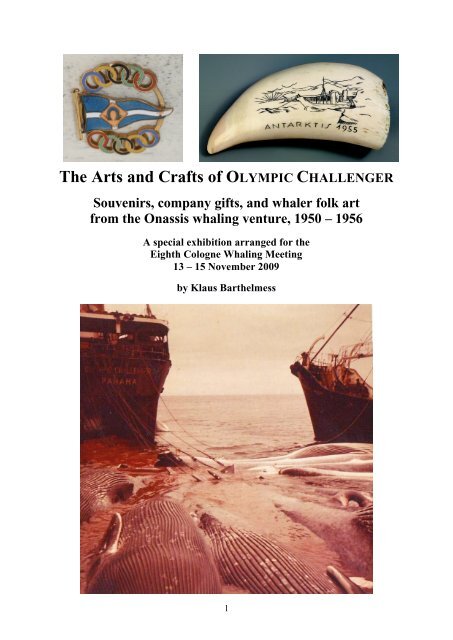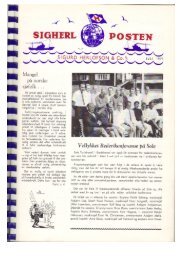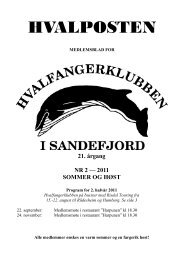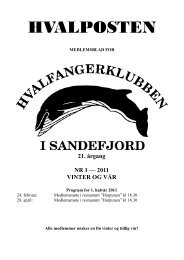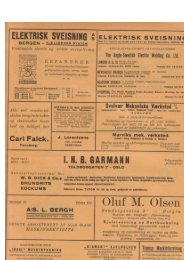Onassis OLYMPIC CHALLENGER souvenir catalogue - Lardex
Onassis OLYMPIC CHALLENGER souvenir catalogue - Lardex
Onassis OLYMPIC CHALLENGER souvenir catalogue - Lardex
You also want an ePaper? Increase the reach of your titles
YUMPU automatically turns print PDFs into web optimized ePapers that Google loves.
The Arts and Crafts of <strong>OLYMPIC</strong> <strong>CHALLENGER</strong><br />
Souvenirs, company gifts, and whaler folk art<br />
from the <strong>Onassis</strong> whaling venture, 1950 – 1956<br />
A special exhibition arranged for the<br />
Eighth Cologne Whaling Meeting<br />
13 – 15 November 2009<br />
by Klaus Barthelmess<br />
1
Introduction<br />
One of the most dramatic chapters of modern whaling history was written by German whalers<br />
under the aegis of the legendary Greek tanker tycoon Aristoteles Socrates <strong>Onassis</strong> (1906-<br />
1975). Between 1950 and 1956 he operated a whaling fleet around floating factory <strong>OLYMPIC</strong><br />
<strong>CHALLENGER</strong>. Most vessels flew the flag-of-convenience of Panama, while some of the 16<br />
catchers were registered in Honduras. Between 96% and 98% of the almost 600 crewmembers<br />
were Germans, quite a few of them with experience from German pre-War whaling. For the<br />
first three seasons 1950/51 to 1952/53, operations were managed by a Hamburg office of the<br />
Erste Deutsche Walfang Gesellschaft (“First German Whaling Co”, founded in 1935), the last<br />
two seasons 1954/55 and 1955/56 (the fleet did not whale in 53/54) by <strong>Onassis</strong>’ management<br />
company Olympic Maritime Agency in Hamburg.<br />
In five whaling seasons, <strong>OLYMPIC</strong> <strong>CHALLENGER</strong> processed more than 22,000 whales. Under<br />
pressure from the management, the stipulations of the new “International Convention for the<br />
Regulation of Whaling” (ICRW) of 1946 were systematically ignored. In one season, 95% of<br />
the sperm whales taken were under the legal size limit, in another the humpback whale quota<br />
was exceeded 14 times, and the resulting higher oil yield was masked by increased statistics<br />
of blue and fin whale catches.<br />
Panama had signed the ICRW, but did not ratify it for several years. In strictly legal terms, the<br />
infractions of the Whaling Convention committed by <strong>OLYMPIC</strong> <strong>CHALLENGER</strong> were thus not<br />
illegal during the first seasons. But they contravened the spirit of the Convention. The<br />
German crew and the Hamburg whale biologists were concerned about their putative “illegal”<br />
conduct, and after two seasons the German government discontinued dispatching scientists<br />
from the Federal Institute for Fisheries Research with the <strong>Onassis</strong> whaling fleet.<br />
What unfolded then, was a dramatic, international and very dirty action story, involving US<br />
secret agents, Norwegian and German transport trade unions, the German Federal Fisheries<br />
Research Institute, the Norwegian Whaling Association, the Peruvian navy, Lloyds of<br />
London, the Erste Deutsche Walfang Gesellschaft in Hamburg, bribery, treason, court action<br />
in Hamburg and Rotterdam, mutual confiscation of ships and whale oil cargoes, plus the<br />
diplomatic efforts of at least half a dozen maritime nations in Europe and the Americas. This<br />
was too much even for an unscrupulous business hardliner like <strong>Onassis</strong>. He sold his whaling<br />
fleet to Japan in 1956. At the end of negotiaions with the Norwegian Whaling Association<br />
about the damages which the Norwegian industry had sustained through his fleet’s infractions<br />
of international whaling regulations, he conceeded to the Norwegian side to keep their face<br />
and to release a faked message that he, <strong>Onassis</strong>, admitted the damage done by <strong>OLYMPIC</strong><br />
<strong>CHALLENGER</strong>.<br />
Little concerned about his own reputation,<br />
ruined as it was anyway, he even let them<br />
spread the word that he paid a penalty of 3<br />
million Dollars intended to build the House<br />
of Whaling (hvalfangstens hus) next to the<br />
harbour of Sandefjord. With <strong>Onassis</strong>’ known<br />
sangfroid and toughness, however, it is more<br />
than likely, that the Norwegian whaler<br />
owners in fact were forced to spent this<br />
money out of their own pockets.<br />
2
Arts and crafts<br />
As house flag, <strong>Onassis</strong> chose a pennant with a white cross on blue ground (the Greek<br />
colours), with the Greek letter Omega – the initial of his name – on a yellow rhombus in the<br />
cross intersection. On the funnel and house mark this pennant was framed above and beneath<br />
by two curved chains of five interlocked rings in the Olympic colours, programmatic of the<br />
vessel name and the challenge this name would pose to the established whaling nations:<br />
<strong>OLYMPIC</strong> <strong>CHALLENGER</strong>. The house mark of Olympic Whaling Company is featured on many<br />
of its give-aways and promotional gifts, but also on officers’ uniform parts and mess room<br />
tableware.<br />
Hunting the largest animal was a thing naturally fascinating a man like <strong>Onassis</strong>. He liked<br />
whaling, not just the business side, but also the very idea of it. He took friends whaling off<br />
Peru, and the furnishings of the bar on board his private yacht CHRISTINA were the gossip of<br />
the yellow press in his time, for the hand rails of the bar were pairs of sperm whale teeth, and<br />
the bar stools were covered with whale penis skin. The lighters he had made in the form of a<br />
harpoon cannon were men’s toys, reflecting his own fascination with the whale hunt (page 6).<br />
Hunting the largest animal also fascinates the common whalemen. Whalers with an artistic<br />
vein often express their fascination by creating folk art. As with almost all folk art objects,<br />
their works are unsigned. Once the artists, their shipmates, friends and relatives are dead, the<br />
artistic expressions of their creativity will pass into anonymity for good.<br />
In this exhibition, styles and hands can be discerned in the scrimshaw and related whaler folk<br />
art. But in most cases, we have to resort to “Notnamen” (substituted names), for the real<br />
names of their makers have already been lost in the oral transmission of the past half-century.<br />
It is hoped that this exhibition stimulates research among the surviving crewmembers of the<br />
<strong>Onassis</strong> whaling venture, so that at least some of the artwork can be salvaged from<br />
anonymity.<br />
Some <strong>Onassis</strong> scrimshander names are recorded, though:<br />
- Richard Ehlers, engine room man on board <strong>OLYMPIC</strong> ARROW (boat 9) made scrimshaw<br />
penguins.<br />
- Kurt Mahler (* 1925), 1 st flenser on the factoryship, created various kinds of sailor folk<br />
art incorporating whale bone and teeth. Though information is contradictory, he may<br />
possibly be the “<strong>Onassis</strong> flat-S scrimshander” (see next page).<br />
- Erich Reupke (1922-1999), radio operator on board <strong>OLYMPIC</strong> LEADER (boat 1) carved<br />
some small pieces in whale bone and tooth.<br />
- Walter Sievers (1912- ca. 2005), from <strong>OLYMPIC</strong> boats 1 and 6, made penguins and other<br />
Antarctic scrimshaw; in the 1980s he turned to creating more challenging objects – esp.<br />
harpoons and harpoon cannon models – from whale bone and teeth collected in the<br />
1950s (page 15).<br />
- Hans-Günter Worm (* 1918), whale worker on the factoryship, fashioned decorative<br />
objects from whale ivory appealing to the wavey taste of the 1950s (page 12).<br />
Some of these men may also have made scrimshaw work, for which we have to resort to<br />
substitute names.<br />
From the hand of the “<strong>Onassis</strong> flag painter” at least seven works are known, distinguishable<br />
by flags (Panama, Honduras, Olympic Whaling Co.) and Olympic Rings, which are painted<br />
on whale teeth and baleen slabs. Often, there are also commemorative inscriptions in German<br />
(page 10). One shipmate in possession of one of his works claimed that the “flag painter” was<br />
a steward on board <strong>OLYMPIC</strong> <strong>CHALLENGER</strong>.<br />
3
At least seven whale teeth (or pairs) are known, which are engraved with very characteristic<br />
icebergs, sun rays and bow views of whaling vessels. Several of them are inscribed in German<br />
capital lettering with a distinctively shallow, ~ - shaped “S”. I have thus resorted to the jocular<br />
substitute name “<strong>Onassis</strong> flat-S scrimshander” (page 11). There is a distant possibility that<br />
he may be Kurt Mahler (see previous page).<br />
Two decorative objects are re-united here for the first time since they were made in<br />
connection with tanker OMIROS (belonging to <strong>Onassis</strong>’ Central American Steamship Co. and<br />
managed by the Erste Deutsche Walfang Gesellschaft) rendezvousing with <strong>OLYMPIC</strong><br />
<strong>CHALLENGER</strong> in the Ross Sea from 20 February to 16 March 1951. In common they have the<br />
use of wood and bright fin whale baleen, as well as an identical German inscription on the<br />
baleen. Their unidentified maker has thus been termed the “OMIROS baleen scribe”. He may<br />
have been Henry Lüchau (1921-1966), a Hamburg pre-war whaleman, who made that voyage<br />
on OMIROS as a cook’s mate and from whose estate one of the two known pieces came (page<br />
13).<br />
At least two teeth engraved with tropical motifs – a bay with palms and some tiny whaling<br />
vessels in the background – are known by a scrimshander affiliated with the second <strong>OLYMPIC</strong><br />
<strong>CHALLENGER</strong> whaling season 1951/52. The fact that one of them carries a label noting<br />
“Aruba” and “Olympic 1951/52” has led to the substitute name “<strong>Onassis</strong> Aruba<br />
scrimshander”.<br />
A polychrome tooth by the “<strong>Onassis</strong> Aruba scrimshander” of 1951/52.<br />
Compare with the piece illustrated on p. 10. From the internet.<br />
4
Official Olympic Whaling Company promotional gifts,<br />
tableware and uniform parts<br />
Olympic Whaling Company lapel<br />
pin.<br />
Cast, bronze-like alloy and enamel.<br />
Manufacturer unknown.<br />
Barthelmess Whaling Collection<br />
Olympic Whaling Company silver<br />
ash tray.<br />
Engraved inscription on the rim:<br />
ANTARKTIS WEIHNACHTEN 1951<br />
Silver mark BRUCKMANN (Hamburg).<br />
Barthelmess Whaling Collection<br />
5<br />
Olympic Whaling Company officer’s<br />
uniform button.<br />
Ormolu (fire-gilt) metal, Ø 16 & 22 mm<br />
Manufacturer’s mark “A”.<br />
Barthelmess Whaling Collection<br />
Olympic Whaling Company cuff links.<br />
A stylized harpoon flanked by the Olympic<br />
rings of the company house mark.<br />
Silver, enamel. Harpoon length 14 mm.<br />
Manufacturer unkown.<br />
Bittlinger Whaling Collection
Olympic Whaling Company representational gift: a mechanical lighter in the<br />
form of a model Bofors harpoon cannon.<br />
Unidentified metal alloy. Total length when loaded 19.7 cm, gun barrel length 9.3 cm (approx<br />
1:15 scale). On the conical gun base engraved presentation placque: “To W.F. Pascoe, O.B.E.<br />
|| Christmas 1953 || Olympic Whaling Company || A.S. <strong>Onassis</strong>”. In the original blue cloth<br />
and velvet presentation box.<br />
These elaborate harpoon cannon models were made by a hitherto unidentified Hamburg<br />
manufacturer in 1952 or 1953, possibly under the supervision of captain Sven W. Thienemann<br />
(1912-2007). The “Baby-Mylflam” or “B 47” lighter mechanism was then built in at Mylflam<br />
company in Offenbach by one Mr. Leibold. Rumour has it that some 150 or 200 harpoon<br />
cannon lighters have been commissioned by the Olympic Whaling Company.<br />
The lighter ignites when the “trigger” under the cannon handle is pressed. The gun can be<br />
swivelled and inclined, the harpoon is detachable, the harpoon grenade can be unscrewed, the<br />
barbs are moveable, and the cardan joint between harpoon head and shank works with a spring<br />
mechanism.<br />
Interestingly, <strong>OLYMPIC</strong> <strong>CHALLENGER</strong> did not whale in the 1953/54 season, when these<br />
mechanical lighters were presented, so they were commissioned before the decision to employ<br />
the floating factory as a tanker was passed.<br />
Since the “Norwegian Whaling (Crew) Act” of 21 December 1945 forbade Norwegian<br />
nationals to promote post-war newcomers to the Antarctic whaling industry, be it through<br />
consultancy, hands-on expertise or supplies, <strong>Onassis</strong>’ whaling fleet – like the Dutch one in<br />
1946 and some post-war Soviet whaling fleets – was not able to purchase the well-tested<br />
Norwegian Kongsberg harpoon cannons, but had to equip their whale catchers with “model<br />
46” harpoon cannons of the Swedish Bofors company. The Hamburg Kampnagel company<br />
supplied harpoons to the Dutch and <strong>Onassis</strong>.<br />
Dedecke Whaling Collection<br />
6
Black plastic matchbook cover with<br />
impressed company house mark.<br />
Dedecke Whaling Collection<br />
Brown plastic notebook cover with<br />
impressed company house mark.<br />
Vonk Whaling Collection<br />
7<br />
Brown leather wallet with impressed<br />
company house mark.<br />
Dedecke Whaling Collection<br />
Photo album “<strong>OLYMPIC</strong> WHALING”<br />
see next page
8<br />
Representation photo album<br />
“<strong>OLYMPIC</strong> WHALING”<br />
n.p. [Hamburg], n.d. [1952]<br />
Blue cloth, 29.5 x 21.5 cm, with impressed<br />
gilt company supralibro, 42 album leaves<br />
pre-printed with German captions in brown,<br />
with ca. 260 b/w and colour photos glued in.<br />
Whaleman Ferdinand Krügel (1925-2008)<br />
furnished the pre-printed albums with prints<br />
made from negatives submitted by several<br />
participants in the 1950/51 and 1951/52<br />
whaling seasons. Crewmembers could buy<br />
albums with or without photos and would<br />
then supplement them with their own photos.<br />
Olympic Whaling Company also distributed<br />
these albums as gifts.<br />
There are said to exist a few representation<br />
albums in larger de-luxe format.<br />
Barthelmess Whaling Collection.<br />
Illustrated are the title page, fol 25 verso-26 recto, and two colour arial photos on fol 10, taken<br />
from the “Hiller 360” helicopter, which <strong>OLYMPIC</strong> <strong>CHALLENGER</strong> had on board in the 1950/51<br />
season for ice reconnaisance and spotting whales. In autumn 1951 it was used for spotting<br />
whales off the coast of Peru only.
Two Olympic Whaling Company promotional postcards.<br />
Produced after the first season, they are captioned in German: “<strong>OLYMPIC</strong> <strong>CHALLENGER</strong> passing<br />
through the North-Sea-Baltic-Canal” and “Provisioning the whale catchers in Montevideo<br />
roadstead”.<br />
Dedecke Whaling Collection<br />
9<br />
Olympic Whaling Company whiskey<br />
and schnapps glasses.<br />
Blown and cut glass with transfer-printed,<br />
white company house mark.<br />
10.2 and 5.8 cm high.<br />
Olympic Whaling Company crew’s mess tableware.<br />
Barthelmess & Dedecke Whaling Collections<br />
Alpaca (German silver), embossed with company logo, marked “NEOVEDA ROSTFREI”.<br />
Dedecke Whaling Collection
Scrimshaw and related whaler folk art<br />
The <strong>Onassis</strong> flag painter:<br />
Company house mark painted on a sperm<br />
whale tooth mounted on whale bone<br />
placque.<br />
Tooth length ca. 15.5 cm.<br />
Dedecke Whaling Collection<br />
The <strong>Onassis</strong> flag painter:<br />
Whale catcher <strong>OLYMPIC</strong> LEADER (boat No.<br />
1) fast to a whale, flags of Panama, Olympic<br />
Whaling Company, and Honduras, Olympic<br />
rings, inscription: “Südpolarexpedition ||<br />
Walfangflotte || „Olympic Challenger“”<br />
painted on a sperm whale tooth, mounted on<br />
wooden base.<br />
Tooth length ca. 15.5 cm<br />
Barthelmess Whaling Collection<br />
10<br />
The <strong>Onassis</strong> flag painter:<br />
Company house mark painted on a piece of<br />
sperm whale jaw bone.<br />
Dimensions ca. 8 x 16 cm.<br />
Vonk Whaling Collection<br />
The <strong>Onassis</strong> Aruba scrimshander:<br />
Engraved sperm whale tooth on wooden<br />
base with square whale bone feet.<br />
Tooth length ca. 20 cm.<br />
Label underneath: “Aruba “Olympic”<br />
1951/52”.<br />
Vonk Whaling Collection
The <strong>Onassis</strong> ‘flat-S’ scrimshander:<br />
Sperm whale tooth engraved with motif of<br />
whale catcher <strong>OLYMPIC</strong> CHASER (boat No.<br />
6) fast to a whale, icebergs and sun rays.<br />
Inscription “ANTARKTIS 1955”<br />
Tooth length ca. 17.5 cm.<br />
Barthelmess Whaling Collection<br />
The <strong>Onassis</strong> ‘flat-S’ scrimshander:<br />
Sperm whale tooth engraved with motif of<br />
whale catcher <strong>OLYMPIC</strong> PROMOTER (boat<br />
No. 4) making fast to a sperm whale,<br />
icebergs. Mounted on wooden base.<br />
Tooth length ca. 16 cm.<br />
Barthelmess Whaling Collection<br />
11<br />
The <strong>Onassis</strong> ‘flat-S’ scrimshander:<br />
Sperm whale tooth engraved with motif of<br />
whale catcher <strong>OLYMPIC</strong> LEADER (boat No.<br />
1) in a heaving sea, iceberg and sun rays.<br />
Inscription “WALFANG 1955”<br />
Tooth length ca. 14 cm.<br />
Dedecke Whaling Collection<br />
Anonymous scrimshander:<br />
Sperm whale tooth with deeply incised<br />
inscription “Olympic || Challenger || 1953”.<br />
Tooth length ca. 10.5 cm.<br />
Barthelmess Whaling Collection<br />
Anonymous scrimshander:<br />
Sperm whale tooth, mounted on lathe-turned<br />
whale bone stem on a foot cut from an<br />
unpolished sperm whale tooth. Deep-cut<br />
inscription “Walfang 55-56 || [house flag] ||<br />
Olympic || Challenger”.<br />
Tooth length ca. 15 cm.<br />
Vonk Whaling Collection
Hans-Günter Worm:<br />
Gull, petrel or albatros. Polished carving<br />
from three pieces of sperm whale ivory.<br />
Wing span ca. 16 cm.<br />
Rosenbohm Whaling Collection<br />
Hans-Günter Worm:<br />
Fish. Polished carving from two pieces of<br />
sperm whale ivory<br />
Height ca. 8.5 cm.<br />
Rosenbohm Whaling Collection<br />
12<br />
Hans-Günter Worm:<br />
Sea horse. Carving, sperm whale ivory,<br />
whale bone, tropical wood, toy glass eye.<br />
Height ca. 15 cm.<br />
Rosenbohm Whaling Collection<br />
Hans-Günter Worm:<br />
Gull, petrel or albatros. Polished carving<br />
from three pieces of sperm whale ivory.<br />
Mahogany base.<br />
Wing span ca. 18 cm.<br />
Rosenbohm Whaling Collection
The OMIROS baleen scribe:<br />
Sail boat model, tropical wood, bright fin<br />
whale baleen, string, metal fittings.<br />
The baleen inscribed: “Walfang || 1950 – 51<br />
|| im Ross Meer || 72° Süd || S.S. “Omiros””<br />
Height ca. 29.5, length ca. 26.5 cm.<br />
Dedecke Whaling Collection<br />
13<br />
The OMIROS baleen scribe:<br />
Desk top, wood, polished sperm whale<br />
tooth, polished rorqual earbone, humpback<br />
whale barnacle (Coronula sp.), bright fin<br />
whale baleen. The baleen with identical<br />
inscription.<br />
Height ca. 37, width ca. 30 cm.<br />
Barthelmess Whaling Collection<br />
Anonymous scrimshander (possibly Johann Henkel, Elsfleth):<br />
Engraved and whitened blue whale baleen slab: harpoon gunner closing in on a whale, giving<br />
steering commands with his right arm. The gun is a Bofors harpoon cannon.<br />
Length ca. 80 cm<br />
Rosenbohm Whaling Collection
Anonymous scrimshander:<br />
Desk top, presumably from Captain Wilhelm Reichert’s shipboard office: mahogany, sperm<br />
whale tooth carved in the shape of a penguin, whale bone feet, brass mountings.<br />
Dimensions 27.6 x 15.2 x 11.8 cm<br />
Underneath stamped with the ship’s seal and the facsimile signature of the captain.<br />
Several penguins carved in the same style – allegedly by a whale worker of <strong>OLYMPIC</strong><br />
<strong>CHALLENGER</strong> - are hitherto known.<br />
Barthelmess Whaling Collection<br />
14
Walter Sievers:<br />
Model of a Bofors harpoon cannon, scale ca.1:10. Whale bone, sperm whale ivory, tropical<br />
wood, metal fittings. The harpoon is detachable, the cannon can be svivelled and inclined.<br />
Total length 32.5 cm.<br />
Barthelmess Whaling Collection<br />
Anonymous artist:<br />
Crossing-the-line baptismal certificates of the <strong>OLYMPIC</strong> <strong>CHALLENGER</strong> 1951/52 season. Note<br />
the slight differences in the hand-drawn background, colouring and the last three typewriter<br />
lines.<br />
Barthelmess and Dedecke Whaling Collections<br />
15
Anonymous artist (possibly<br />
Ferdinand Krügel):<br />
Pre-printed line baptismal certificate for the<br />
<strong>OLYMPIC</strong> <strong>CHALLENGER</strong> 1952/53 season,<br />
bound in the company’s album (see above),<br />
fol 5 verso.<br />
Barthelmess Whaling Collection<br />
Afterlude<br />
16<br />
Paul Moehlke, printers, Hamburg:<br />
Vessel-unspecific, whaling-unrelated, preprinted<br />
line baptismal certificate, with<br />
blanks filled in for the <strong>OLYMPIC</strong><br />
<strong>CHALLENGER</strong> 1954/55 season.<br />
Vonk Whaling Collection<br />
Showa Label Co., printers: Seasoned whale meat can label featuring the fourfunnelled<br />
KYOKUYO MARU No. 2, ex-<strong>OLYMPIC</strong> <strong>CHALLENGER</strong>.<br />
After the 1955/56 season, <strong>Onassis</strong> sold his whaling fleet to Kyokuyo Hogei KK (Polar Seas<br />
Whaling Co.). Under Japanese flag, the factoryship whaled from 1956/57 to 1973/74 and was<br />
then scrapped. The <strong>OLYMPIC</strong> catcher boats were renamed OTORI MARU (plus numbers).<br />
Barthelmess Whaling Collection
Acknowledgements<br />
I wish to thank<br />
- Holger Bittlinger, Koldenbüttel<br />
- Ralf Dedecke, Hanau<br />
- Gert Rosenbohm, Brake<br />
- Adrie & Ineke Vonk, Texel<br />
for generously loaning their rare or unique <strong>Onassis</strong> whaling paraphernalia to this special<br />
exhibition, for their willing cooperation on the <strong>catalogue</strong>, and their exhaustive replies to my<br />
unnerving questions.<br />
All whale products exhibited or illustrated here are certified pre-convention items under<br />
CITES regulations and related national legislation.<br />
Literature<br />
17<br />
Klaus Barthelmess, November 2009<br />
Barthelmess, Klaus: „A Century of German Interests in Modern Whaling, 1860s - 1960s“, in:<br />
Bjørn L. Basberg, Jan Erik Ringstad & Einar Wexelsen (Hrgg.): Whaling and History –<br />
Perspectives on the Evolution of the Industry (= Kommandør Chr. Christensens<br />
Hvalfangstmuseum, publikasjon 29). Sandefjord, 1993, pp. 121-138.<br />
Barthelmess, Klaus: „<strong>OLYMPIC</strong> <strong>CHALLENGER</strong>s Verstöße gegen Walfangbestimmungen,<br />
1950/51 - 1955/56“, in: Deutsches Schiffahrtsarchiv, 19, 1996, pp. 67-86.<br />
Barthelmess, Klaus, Karl-Hermann Kock & Erich Reupke: „Validation of catch data of the<br />
‘Olympic Challenger’ whaling operations from 1950/51 to 195/56“, in: International<br />
Whaling Commission (ed.): Reports of the International Whaling Commission, 47, 1997,<br />
pp. 937-940.<br />
Barthelmess, Klaus: The arts of modern whaling (= Commander Chr. Christensen’s Whaling<br />
Museum, Publication 32). Sandefjord, 2007.<br />
Barthelmess, Klaus (in press): „Die Gegner der <strong>OLYMPIC</strong> <strong>CHALLENGER</strong>. Wie amerikanische<br />
Geheimdienste, Norweger und Deutsche das Walfangabenteuer des Aristoteles <strong>Onassis</strong><br />
beendeten”<br />
Bohmert, Friedrich: Der Walfang der Ersten Deutschen Walfang Gesellschaft. Ein Beitrag<br />
zur Geschichte des Unternehmens Henkel. Düsseldorf, 1982. Also published in a shortened<br />
and illustrated version as: Vom Fang der Wale zum Schutz der Wale. Wie Henkel Wale fing<br />
und einen Beitrag zu ihrer Rettung leistete (= Schriften des Werksarchivs der Henkel<br />
KGaA Düsseldorf, 14). Düsseldorf, 1982.<br />
Winterhoff, Edmund: Walfang in der Antarktis (= Schriften des Deutschen<br />
Schiffahrsmuseums Bremerhaven, 4). Hamburg, 1974.


